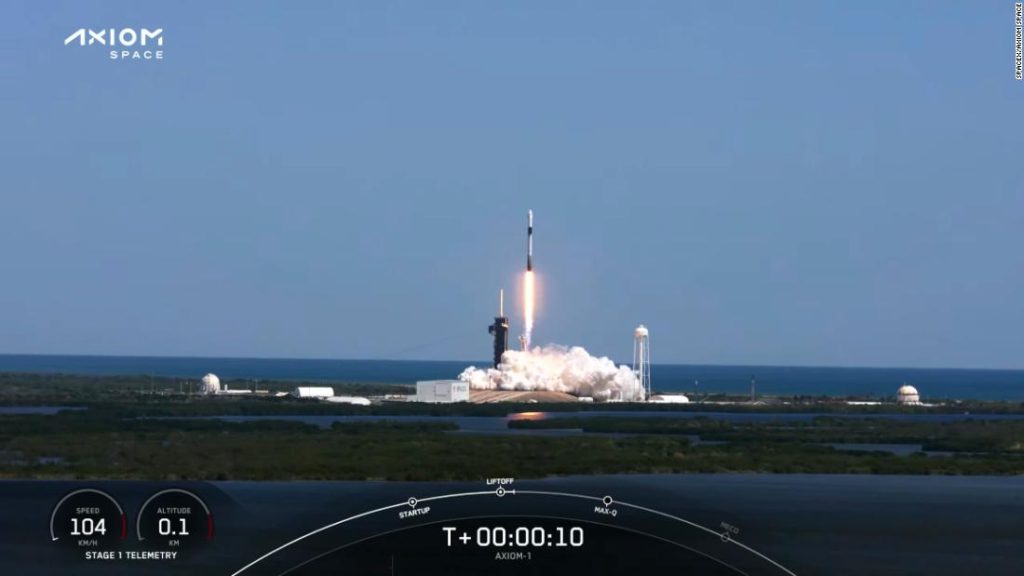
The spacecraft, which detached from the rocket after reaching orbit, is now flying freely through orbit and will spend all Friday maneuvering slowly near the International Space Station, where it is scheduled to dock Saturday at about 7:45 a.m. ET.
The trip was made by Houston, Texas-based startup Axiom Space, which seeks to book rocket flights, provide all the necessary training, and coordinate flights to the International Space Station for anyone who can afford them. All of this is in line with the goal of the US government and the private sector to promote commercial activity on and off the International Space Station.
Aboard this mission, called AX-1, is Michael Lopez Alegria, a former NASA astronaut turned Axiom employee who is leading the mission; Israeli businessman Eitan Stibi. Canadian investor Mark Pathy; Ohio real estate magnate Larry Connor.
This isn’t the first time customers or non-astronauts have paid to visit the International Space Station, as Russia has sold seats on its Soyuz spacecraft to many wealthy thrill seekers. in past years. But this is the first mission to have a crew made up entirely of ordinary citizens without active members of the government’s astronaut corps. It is also the first time that ordinary citizens have traveled to the International Space Station aboard a US-made spacecraft.
Here’s everything you need to know.
How much does all this cost?
The mission is made possible by close coordination between Axiom, SpaceX and NASA, since the International Space Station is government funded and operated.
Food alone costs $2,000 a day, per person, in space. Getting supplies to and from the space station for a commercial crew is $88,000 to $164,000 per person, per day. For each mission, getting the necessary support from NASA astronauts would cost commercial customers another $5.2 million, and all mission support and planning NASA lends is another $4.8 million.
Who is flying?
Is it safe to go to the International Space Station, given the Russian conflict?
Russia is the primary partner of the United States on the International Space Station, and the space station has long been hailed as a symbol of post-Cold War cooperation.
Despite all the hype, NASA has repeatedly sought to reassure that NASA and its Russian counterparts are working together seamlessly behind the scenes.
“NASA is aware of recent comments regarding the International Space Station. US sanctions and export control measures continue to allow US-Russia space cooperation on the space station,” NASA Administrator Bill Nelson said in a recent statement. “The professional relationship between our international partners, astronauts and astronauts continues for the safety and mission of everyone aboard the International Space Station.”
Are they astronauts or tourists?
That’s a question hanging over the spaceflight community right now.
The US government has traditionally awarded astronaut wings to anyone who travels more than 50 miles above the Earth’s surface. But commercial astronaut wings – a relatively new designation introduced by the Federal Aviation Administration – may not be distributed quite liberally.
Whether it is fair to continue referring to the people who pay for their way into space as “astronauts” is an open question, and countless observers – including NASA astronauts – have given their opinion.
If you ask the AX-1 crew, they don’t like being referred to as “tourists.”
Lopez Allegria told reporters earlier this month, referring to supersonic flights by Jeff Bezos Blue Origin. “I think there is an important role for space tourism, but that’s not what Axiom means.”
The crew underwent extensive training for this mission, undertaking many of the same tasks as professional astronauts in training. But the truth is that the three paying clients on this journey – Stibbe, Pathy and Connor – were not chosen from among a pool of thousands of applicants and don’t devote much of their lives to this endeavor.
Axiom itself has been more fickle about the use of words in the past.
What will they do while they are in space?
Each crew member has a list of research projects they plan to work on.
Connor will do some research on how spaceflight affects senescent cells, which are cells that have halted the normal reproduction process and are “associated with multiple age-related diseases,” according to Axiom. This research will be conducted in partnership with Mayo Clinic and Cleveland Clinic.
Among the items on Pathé’s to-do list are some additional medical research, focused more on children’s health, which he will be conducting in partnership with several Canadian hospitals, and some conservation outreach initiatives.
Stibbe will also conduct some research and focus on “educational and artistic activities to connect the younger generation in Israel and around the world,” according to Axiom. Stipe flies on behalf of the Ramon Foundation – a non-profit space education organization named after the first Israeli astronaut, Ilan Ramon, who died in the space shuttle Columbia disaster in 2003. Stipe’s biography says he and Ramon share a “close” friendship.
During the layover, the crew will also have the opportunity to enjoy sweeping views of the land. And at some point, they’ll share a meal with the other astronauts on board. Their food was prepared in partnership with celebrity chef and philanthropist Jose Andres. According to Axiom, their meals are “based on the traditional flavors and dishes of Commander Lopez-Alegria’s indigenous Spain.”




More Stories
Boeing May Not Be Able to Operate Starliner Before Space Station Is Destroyed
Prehistoric sea cow eaten by crocodile and shark, fossils say
UNC student to become youngest woman to cross space on Blue Origin